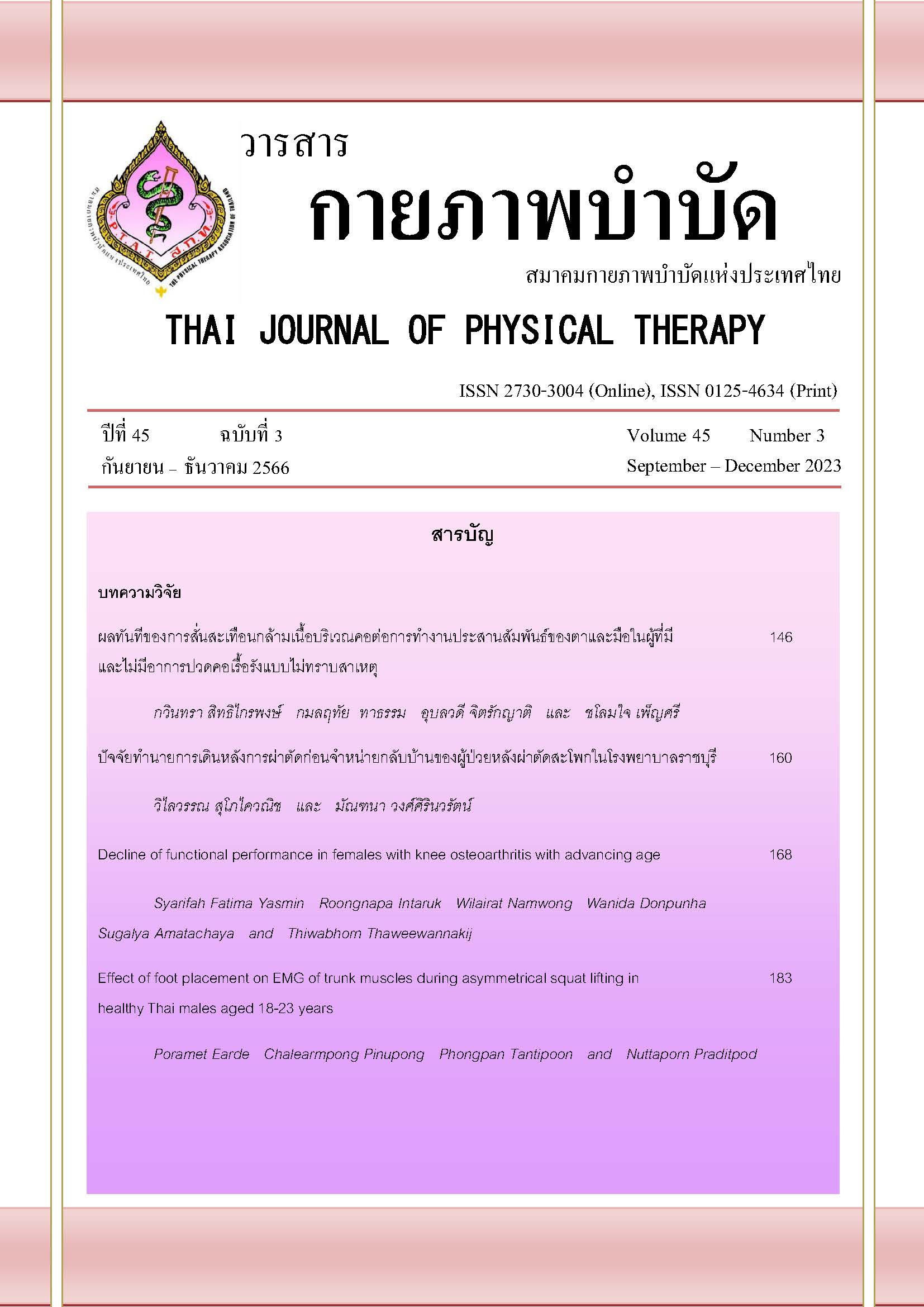Effect of foot placement on EMG of trunk muscles during asymmetrical squat lifting in healthy Thai males aged 18-23 years
Main Article Content
บทคัดย่อ
Background: Torso twisting during lifting represents an asymmetrical posture that can result in bodily injuries. Foot positioning while lifting is one of the factors used in posture design to reduce the risk of injuries. However, the impact of foot positioning on the trunk muscle activity in asymmetrical lifting is still uncertain.
Objective: To investigate the effect of foot placement on the electromyographic activity of trunk muscles during asymmetrical squat lifting.
Method: Thirty-one males participated in the study. All participants were asked to lift a 7-kilogram box measuring 36x26x28 centimeters from the floor to a stand at hip level on the right side. Two types of foot placement were investigated: equal foot position (EP) and left forward stride position (LP). Eight electromyography (EMG) of both sides of lumbar erector spinae (ES), multifidus (MF), internal abdominal oblique (IO), and external abdominal oblique (EO) were performed. The percent of MVC of average amplitude EMG of the lifting and twisting phases of the lifting task was analyzed.
Results: The results showed higher activity of IO, ES, and MF during the twisting phase (p<0.05), and the right ES worked harder than the left during the twisting phase in both foot positions (p<0.05). However, activity of the right IO was greater than left IO during the twisting phase in EP.
Conclusion: The foot position did not affect the EMG of the investigated trunk muscles during asymmetrical lifting. However, IO, ES, and MF showed higher activity in both foot positions during the trunk twist.
Article Details

อนุญาตภายใต้เงื่อนไข Creative Commons Attribution-NonCommercial-NoDerivatives 4.0 International License.
เอกสารอ้างอิง
Jansen JP, Hoozemans MJ, Van Der Beek AJ, Frings-Dresen MH. Evaluation of ergonomic adjustments of catering carts to reduce external pushing forces. Appl Ergon. 2002;33(2):117-27.
Da Costa BR, Vieira ER. Risk factors for work-related musculoskeletal disorders: a systematic review of recent longitudinal studies. Am J Ind Med. 2010;53(3):285-323.
Keyserling WM. Workplace risk factors and occupational musculoskeletal disorders, Part 1: A review of biomechanical and psychophysical research on risk factors associated with low-back pain. AIHAJ. 2000;61(1):39-50.
Coenen P, Kingma I, Boot CR, Twisk JW, Bongers PM, van Dieën JH. Cumulative low back load at work as a risk factor of low back pain: a prospective cohort study. J Occup Rehabil. 2013 Mar;23(1):11-8.
Cole MH, Grimshaw PN. Low back pain and lifting: a review of epidemiology and aetiology. Work. 2003 Jan 1;21(2):173-84.
Kim HK, Zhang Y. Estimation of lumbar spinal loading and trunk muscle forces during asymmetric lifting tasks: application of whole-body musculoskeletal modelling in OpenSim. Ergonomics. 2017;60(4):563-76.
Kingma I, van Dieen JH, de Looze M, Toussaint HM, Dolan P, Baten CT. Asymmetric low back loading in asymmetric lifting movements is not prevented by pelvic twist. J Biomech. 1998;31(6):527-34.
Danneels LA, Vanderstraeten GG, Cambier DC, Witvrouw EE, Stevens VK, De Cuyper HJ. A functional subdivision of hip, abdominal, and back muscles during asymmetric lifting. Spine. 2001;26(6):E114-21.
Kingma I, Bosch T, Bruins L, Van Dieën JH. Foot positioning instruction, initial vertical load position, and lifting technique: effects on low back loading. Ergonomics. 2004;47(13):1365-85.
Konz SA, Bhasin R. Foot position during lifting. Am Ind Hyg Assoc J. 1974;35(12):785-92.
Kingma I, Faber GS, Bakker AJ, Van Dieen JH. Can low back loading during lifting be reduced by placing one leg beside the object to be lifted? Phys Ther. 2006;86(8):1091-105.
Marras WS, Mirka GA. A comprehensive evaluation of trunk response to asymmetric trunk motion. Spine (Phila PA 1976). 1992; 17(3):318-26.
Zhou J, Dai B, Ning X. The assessment of material handling strategies in dealing with sudden loading: influences of foot placement on trunk biomechanics. Ergonomics. 2013; 56(10):1569-76.
Warburton DE, Jamnik VK, Bredin SS, McKenzie DC, Stone J, Shephard RJ, et al. Evidence-based risk assessment and recommendations for physical activity clearance: an introduction. Appl Physiol Nutr Metab. 2011;36(Suppl 1):S1-2.
Lee K. The relationship of trunk muscle activation and core stability: a biomechanical analysis of Pilates-based stabilization exercise. Int J Environ Res Public Health. 2021 Dec 4;18(23):12804.
Salehi Sahl Abadi A, Mazloumi A, Nasl Saraji G, Zeraati H, Hadian MR, Jafari AH. Determining Changes in Electromyography Indices when Measuring Maximum Acceptable Weight of Lift in Iranian Male Students. J Biomed Phys Eng. 2018;8(1):73-86.
Marras WS, Davis KG, Granata KP. Trunk muscle activities during asymmetric twisting motions. J Electromyogr Kinesiol. 1998;8(4): 247-56.
Kawabata M, Shima N, Nishizono H. Regular change in spontaneous preparative behaviour on intra-abdominal pressure and breathing during dynamic lifting. Eur J Appl Physiol. 2014;114(11):2233-9.
Lamberg EM, Hagins M. Breath control during manual free-style lifting of a maximally tolerated load. Ergonomics. 2010;53(3):385-92.
O'Sullivan PB, Phyty GD, Twomey LT, Allison GT. Evaluation of specific stabilizing exercise in the treatment of chronic low back pain with radiologic diagnosis of spondylolysis or spondylolisthesis. Spine (Phila Pa 1976). 1997;22(24):2959-67.
Kim SH, Chung MK. Effects of posture, weight and frequency on trunk muscular activity and fatigue during repetitive lifting tasks. Ergonomics. 1995;38(5):853-63.
de Moraes AC, Bankoff AD. Electromyography response of the iliocostalis lumborum muscle during flexion, extension and rotation movements of the trunk in orthostatic and seated position. Electromyogr Clin Neurophysiol. 2003;43(4):241-9.
Bankoff AD, Moraes AC, Salve MG, Lopes MB, Ferrarezi MP. Electromyographical study of the iliocostalis lumborum, longissimus thoracis and spinalis thoracis muscles in various positions and movements. Electromyogr Clin Neurophysiol. 2000;40(6): 345-9.


